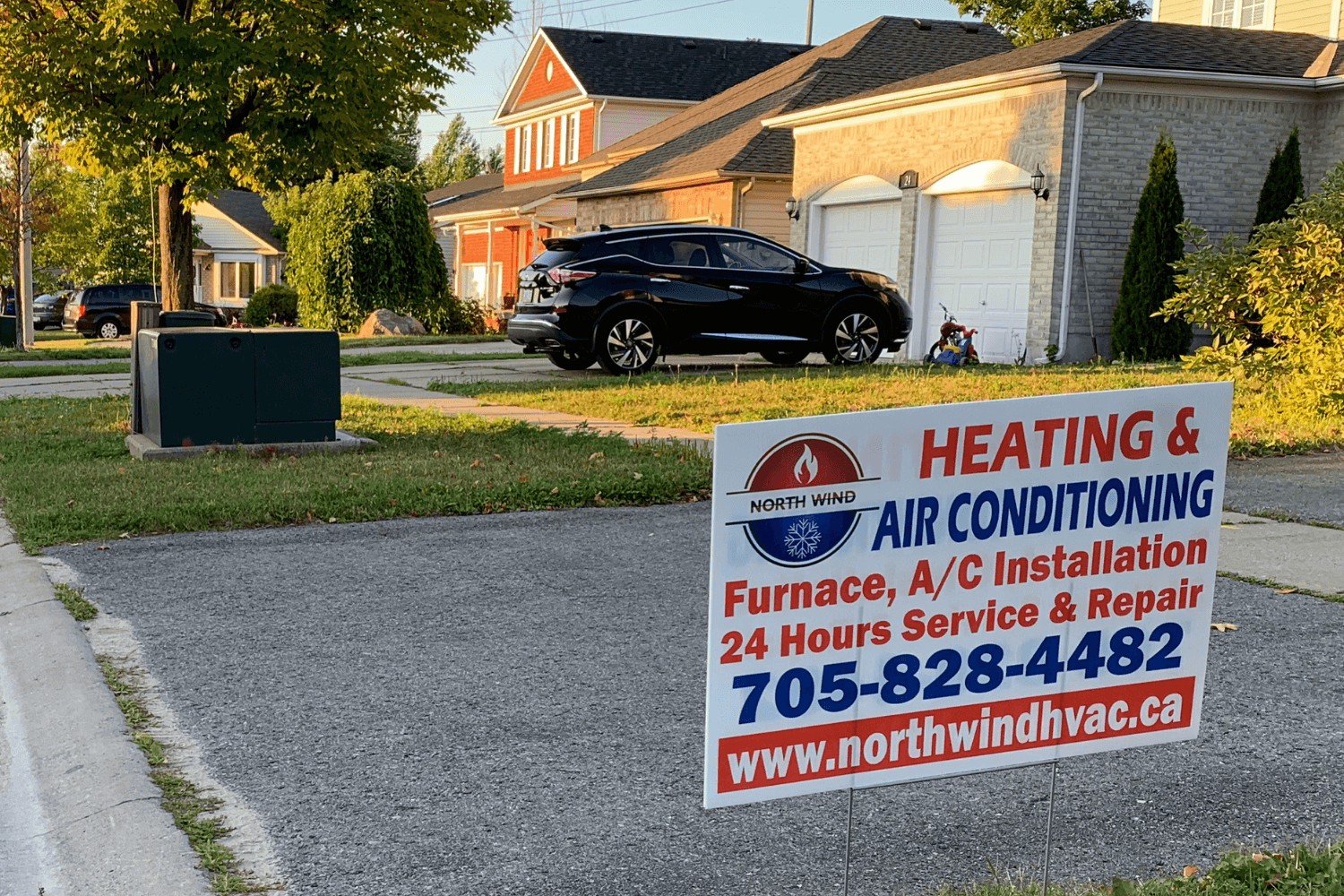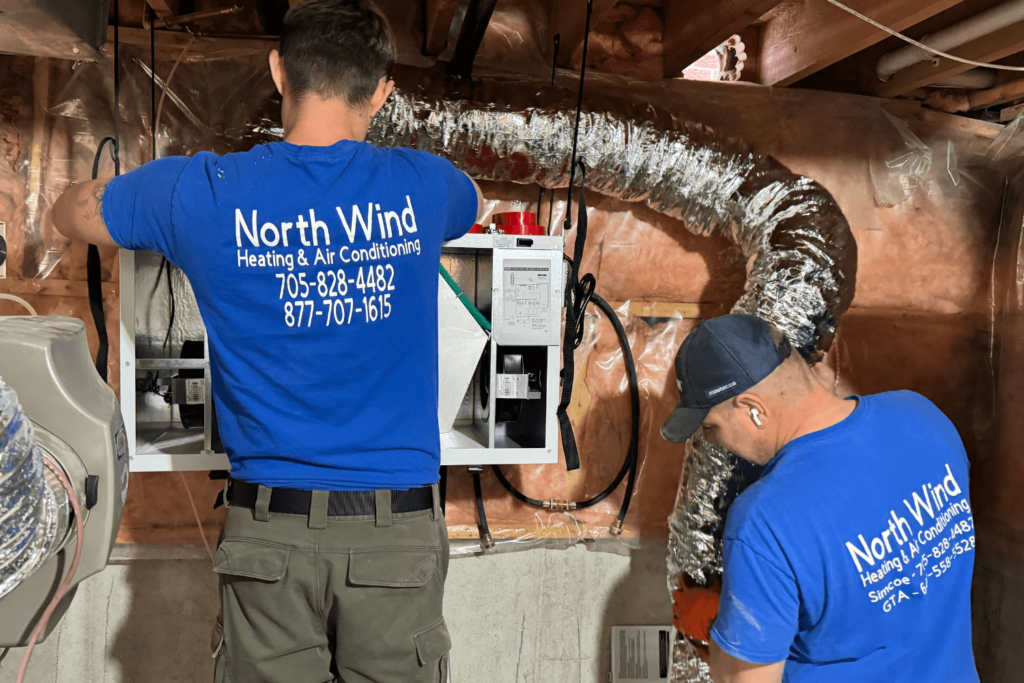Table Of Contents:
Understanding Furnace Size
What Are BTUs?
What Are Climate Zones?
How Do Climate Zones Affect You in Ontario?
Calculating Your Furnace Size
Other Factors That Influence the Size of Your Furnace
1. Windows
2. Age Of Home
3. Ceiling Height
4. Ceiling Fans
5. Ductwork
When we talk about furnace size, we don’t mean the physical dimensions of the unit. Instead, we’re talking about its heating capacity which is measured in BTUs (British Thermal Units). The higher the BTU rating, the more powerful the furnace!
Understanding Furnace Size
Before you run out to buy a new furnace, stop and think… what size furnace do I really need?
The first thing to know about furnace sizing is that it’s not just about matching a furnace to the square footage of your home. That is a great starting point, however, there are other considerations, such as your home’s insulation, number of windows, ceiling height, and even your home’s position in the sun. When you combine all of these factors, you will have a much clearer picture of what size furnace your home needs.
Learn about the different types of furnaces available here!
What Are BTUs? How to Calculate the Correct BTUs Needed for Your New Furnace?
BTU stands for British Thermal Unit, it’s the standard measurement used to determine the heating capacity of a furnace. Essentially, a BTU measures how much energy is needed to raise the temperature of one pound of water by one degree Fahrenheit.
To estimate the BTUs needed for your new furnace, calculate the square footage of your home, and multiply it by the recommended number of BTUs for your climate zone (we’ll get into this next). For example, if you have a 2,000-square-foot home and live in a climate zone that requires 45 BTUs per square foot, you would need a furnace with a capacity of about 90,000 BTUs.
But remember, this is just the starting point. Several other factors will influence the final BTU requirement, so don’t stop here.

What Are Climate Zones? How Do They Affect Your New Furnace?
Climate zones are geographic areas defined by specific temperature ranges, which influence the level of heating (or cooling) your home needs. When furnace sizing, understanding your climate zone is important because it directly impacts how many BTUs per square foot your home will need to stay warm during the winter months.
Here’s a breakdown of the climate zones in North America:
Zone 1: The warmest climate zone, found in regions like southern Florida and southern Texas. Homes in Zone 1 generally require about 30 to 35 BTUs per square foot.
Zone 2: This zone includes areas with a Mediterranean climate, such as coastal California and parts of Tennessee. In Zone 2, homes typically need 35 to 40 BTUs per square foot.
Zone 3: Found in regions with oceanic and humid continental climates, like Missouri and Virginia. Homes in Zone 3 require 40 to 45 BTUs per square foot.
Zone 4: Covering semi-arid and humid continental climates, including the majority of Southern Ontario. In Zone 4, homes generally need 45 to 50 BTUs per square foot.
Zone 5: This zone represents alpine and colder humid-continental climates, such as Barrie and Muskoka. Homes in Zone 5 require about 50 to 60 BTUs per square foot due to the colder winter temperatures.
Zone 6: A colder zone found in areas in northern parts of Canada, where winters are severe. Homes here might require 55 to 65 BTUs per square foot.
Zone 7: The coldest zone, typically found in the northernmost parts of Canada. Homes in Zone 7 might require 60 to 70 BTUs per square foot, given the extreme winter conditions.
How Do Climate Zones Affect You in Ontario?
Ontario’s climate varies significantly depending on where you are in the province. The majority of Ontario, including areas like Toronto and the Greater Toronto Area (GTA), falls within Zone 4. You’ll typically need about 45 to 50 BTUs per square foot to keep your home warm and comfortable throughout the winter.
As you move further north, towards areas like Barrie, Orillia, and the Muskoka region, you enter Zone 5. Homes should plan 50 to 60 BTUs per square foot to stay warm during the coldest months.
Calculating Your Furnace Size
Now that you understand BTUs and climate zones, let’s put it all together. Here’s a simple formula to estimate the furnace size you need:
Square Footage of Your Home x Climate Zone Heating Factor = Total BTUs Needed
For instance, if you have a 1,800-square-foot home in Toronto (Zone 4), and you use a heating factor of 50 BTUs per square foot, you’d calculate:
1,800 sq. ft. x 50 BTUs = 90,000 BTUs
This means you’d start by looking for a furnace that offers around 90,000 BTUs. But before running out to buy a new 90,000 BTU furnace, there are a few more factors to consider.

Other Factors That Influence the Size of Your Furnace
Even with a BTU estimate, other factors can affect how much heating power you need Here’s a breakdown of the most important factors you should consider:
Windows
Windows are one of the biggest culprits when it comes to heat loss. Older windows, in particular, can be warped and drafty, allowing warm air to escape and cold air to seep in. If your home has a lot of windows, especially if they’re older or single-pane, you might need a furnace at the higher end of your BTU range to compensate for this heat loss.
Age Of Home
The age of your home plays a crucial role in determining your furnace size. Older homes, especially those built before the 1980s, tend to have less efficient insulation and may require more BTUs to keep warm. Alternatively, newer homes are typically better insulated, allowing you to opt for a furnace at the lower end of your BTU range.
Ceiling Height
Higher ceilings mean more space for warm air to fill, which can increase the BTU requirement. Standard ceilings are typically 8 to 9 feet high. If your home has vaulted or cathedral ceilings, you’ll need a furnace with a higher BTU rating to ensure that the entire space is heated.
Ceiling Fans
Ceiling fans can actually help distribute heat more evenly throughout your home by pushing warm air down from the ceiling. If you have ceiling fans, you might find that your home heats more efficiently, potentially allowing you to opt for a slightly smaller furnace.
Ductwork
Your home’s ductwork is the system that distributes warm air throughout your home. If your ductwork is old, leaky, or not properly sized for your furnace, it can significantly impact the efficiency of your heating system. In some cases, poorly maintained or undersized ductwork can even cause your furnace to work harder than necessary, leading to higher energy bills and future furnace repairs.
Choosing the right size furnace for your Ontario home doesn’t have to be a daunting task. By understanding the importance of BTUs, recognizing how climate zones affect your heating needs, and considering factors like insulation, windows, and ceiling height, you can make an informed decision that keeps your home warm and comfortable all winter long.
If you’re in the market for a new furnace or have questions about the right size for your home, don’t hesitate to contact us at North Wind HVAC. We’re here to make sure your home stays warm, no matter how cold Ontario winters get!
